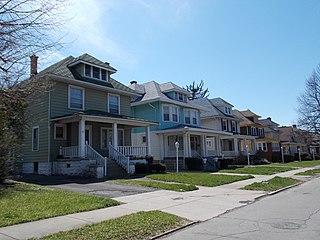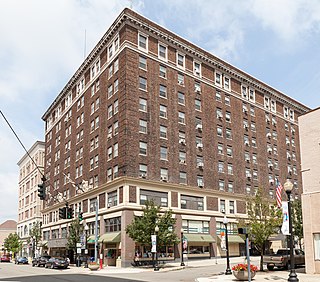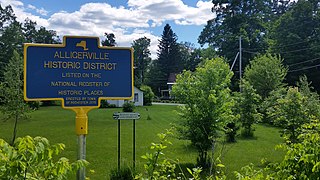
The Central Troy Historic District is an irregularly shaped, 96-acre (39 ha) area of downtown Troy, New York, United States. It has been described as "one of the most perfectly preserved 19th-century downtowns in the [country]" with nearly 700 properties in a variety of architectural styles from the early 19th to mid-20th centuries. These include most of Russell Sage College, one of two privately owned urban parks in New York, and two National Historic Landmarks. Visitors ranging from the Duke de la Rochefoucauld to Philip Johnson have praised aspects of it. Martin Scorsese used parts of downtown Troy as a stand-in for 19th-century Manhattan in The Age of Innocence.

The Old Chestnut Hill Historic District encompasses the historic residential heart of the Newton portion of Chestnut Hill, Massachusetts. When first listed on the National Register of Historic Places in 1986, the district extended along Hammond Street, between Beacon Street and the MBTA Green Line right-of-way, and along Chestnut Hill Road between Hammond and Essex, including properties along a few adjacent streets. The district was expanded in 1990 to include more of Chestnut Hill Road and Essex Road, Suffolk Road and the roads between it and Hammond, and a small section south of the Green Line including properties on Hammond Street, Longwood Road, and Middlesex Road. A further expansion in 1999 added a single property on Suffolk Road.

There are 73 properties listed on the National Register of Historic Places in Albany, New York, United States. Six are additionally designated as National Historic Landmarks (NHLs), the most of any city in the state after New York City. Another 14 are historic districts, for which 20 of the listings are also contributing properties. Two properties, both buildings, that had been listed in the past but have since been demolished have been delisted; one building that is also no longer extant remains listed.

Canajoharie Historic District is a national historic district located at Canajoharie in Montgomery County, New York. It encompasses 836 contributing buildings, 4 contributing sites, 11 contributing structures, and 19 contributing objects in the central business district and surrounding residential sections of the village of Canajoharie. It developed between about 1750 and 1959, and includes notable examples of Greek Revival, Italianate, Queen Anne, Colonial Revival, Tudor Revival, and Bungalow / American Craftsman style architecture. Located in the district are the separately listed Bragdon-Lipe House, the Van Alstyne House, the West Hill School, and the United States Post Office. Other notable contributing resources include the Village Hall (1941), Canajoharie Creamery, Beech-Nut No. 1 Plant, Beech-Nut No. 2 Plant, Reformed church (1842), Episcopal Church of the Good Shepherd (1874), St. Mark's Lutheran Church (1868), Saints Peter and Paul Roman Catholic church, Sayles Building (1868), and the Arkell Foundation complex.

Central Avenue Historic District is a national historic district located at Lancaster in Erie County, New York. The district encompasses 17 contributing buildings in the central business district of the village of Lancaster. The district includes a variety of residential, commercial, and government buildings built between about 1860 and 1940. It includes notable examples of Italianate and Colonial Revival style architecture. Notable buildings include the Lancaster Town Hall and Opera House, Former Post Office, Cushing Block, and Potter-Eaton House.

Hamlin Park Historic District is a national historic district and neighborhood located at Buffalo in Erie County, New York. The district encompasses 1,368 contributing buildings, 3 contributing sites, and 6 contributing structures in a predominantly residential section of Buffalo. The district includes a variety of residential buildings built primarily between about 1895 and 1930, and later improved through Model Cities Program grants between 1966 and 1975. It includes a variety of pattern book houses in popular architectural styles of the late-19th and early-20th century, with some interspersed Bungalow / American Craftsman style dwellings. Located in the district are the separately listed Robert T. Coles House and Studio and Stone Farmhouse. Other notable buildings include the Lutheran Church Home (1906), the former Second United Presbyterian Church (1920), and the former St. Francis DeSales Roman Catholic Church (1926).

Market Square Historic District is a national historic district located in the Black Rock neighborhood of Buffalo in Erie County, New York. The district encompasses 15 contributing buildings and 1 contributing site in a mixed residential and commercial section of Buffalo. The district developed between about 1830 and 1912, and includes a buildings in a variety of architectural styles including Federal, Gothic Revival, Italianate, Queen Anne, Romanesque Revival, and Bungalow / American Craftsman. Located in the district is the separately listed St. Francis Xavier Roman Catholic Parish Complex. Other notable contributing resources include the Market Square (1830), Black Rock Savings and Loan (1870-1910), Firehouse Engine #15 (1912), Smith House and Tavern, St. John's Church (1894), and Howell House and Store.

High and Locust Streets Historic District is a national historic district located at Lockport in Niagara County, New York. The district encompasses 120 contributing buildings in a predominantly residential section of Lockport. The district developed between about 1840 and 1936, and includes buildings in a variety of architectural styles including Greek Revival, Italianate, Queen Anne, Colonial Revival, Classical Revival, and Bungalow / American Craftsman. Located in the district are the separately listed Chase-Crowley-Keep House, Chase-Hubbard-Williams House, and Thomas Oliver House. Other notable buildings include the F.N. Nelson House, Calvin Haines/Alonzo J. Mansfield House, J. Dunville House, Ambrose S. Beverly House, Dr. Martin S. Kittinger House, and F. N. Nelson House/Lockport Home for the Friendless.

Jamestown Downtown Historic District is a national historic district located at Jamestown in Chautauqua County, New York. The district encompasses 103 contributing buildings in the central business district of Jamestown. The district developed between about 1873 and 1956, and includes buildings in a variety of architectural styles including Italianate, Gothic Revival, Second Empire, Romanesque Revival, Classical Revival, Renaissance Revival, and Art Deco. Located in the district is the separately listed Wellman Building. Other notable buildings include the Arcade Building (1898), Odd Fellows Lodge (1914), Bank of Jamestown, Hotel Samuels (1910), Hotel Jamestown (1924), Chautauqua School of Nursing (1911), Jamestown Telephone Company (1930), Maddox Building (1933), First National Bank (1953), Pennsylvania Gas Company building, Chautauqua National Bank (1956), Palace Theatre, Allen's Opera House, and the former Broadhead Worsted Mills.

Attica Market and Main Historic District is a national historic district located at Attica in Wyoming County, New York. The district encompasses 23 contributing buildings in the central business district of Attica. The district developed between about 1827 and 1915, and includes buildings in a variety of architectural styles including Greek Revival, Italianate, Second Empire, and Romanesque Revival. Notable buildings include the Farmer's Bank (1856), Walbridge Block (1853), Pfender Block, Young-Krauss Block (1907), Scott Building (1827), American Hall (1872), the Hardware Block (1853), and Masonic Temple (1908).

Maple Avenue Historic District is a national historic district located at Elmira, Chemung County, New York. It encompasses 121 contributing buildings and four contributing objects in a predominantly residential section of Elmira. It developed between about 1869 and 1940, and includes notable examples of Italianate, Second Empire, Queen Anne, Colonial Revival, and American Craftsman style architecture. Located in the district are the separately listed John Brand Jr. House, John Brand Sr. House, and Alexander Eustace House. Other notable buildings are the J.H. Harris House (1892), Samuel W. Clark House, James H. Clark House, and Horace W. Personius House (1913).

Crown Heights North Historic District is a national historic district located in the Crown Heights neighborhood of Brooklyn, Kings County, New York. The district encompasses 1,019 contributing buildings in a predominantly residential section of Brooklyn. The district features noteworthy examples of Greek Revival, Gothic Revival, Italianate, Second Empire, Queen Anne, Romanesque Revival, Renaissance Revival, Beaux-Arts, and Colonial Revival style architecture. It largely developed between about 1853 and 1942, and consists of densely constructed rowhouses, townhouses, two-family houses, semi-attached houses, freestanding houses, flats, apartment buildings, and institutional and commercial buildings.

East Hill Historic District is a national historic district located at Springville in Erie County, New York. The district encompasses 59 contributing buildings and 2 contributing objects in the original residential district of the village of Springville. The district includes a variety of residential buildings built between about 1835 and 1935. It includes notable examples of Greek Revival, Italianate, Queen Anne, Colonial Revival, and Bungalow / American Craftsman style architecture. Notable buildings include the George E. Crandall House / Warner Museum, Frank O. Smith House, C.J. Shuttleworth House, Morris Hall House (1892), and Inez Wiggins House.

Broadway Historic District is a national historic district located at Lancaster in Erie County, New York. The district encompasses 85 contributing resources in the village of Lancaster. The district includes a variety of commercial, residential, religious and institutional buildings built between about 1831 and 1940. It includes notable examples of Greek Revival, Italianate, Queen Anne, Colonial Revival, and Bungalow / American Craftsman style architecture. Located in the district are the separately listed Lancaster Municipal Building (1940), Miller-Mackey House, Clark-Lester House, Bruce-Briggs Brick Block, Lancaster Masonic Lodge Hall (1916-1919), Liebler-Rohl Gasoline Station, Dr. John J. Nowak House, Zuidema-Idsardi House, Herman B. VanPeyma House, and John Richardson House. Other notable buildings include the Seeger Store Building, Brost Building designed by Edward Brodhead Green, Maute House, Depew Lancaster Moose Lodge No. 1605 B.P.O.E. Lodge/Potter's Hall, and Lancaster Presbyterian Church (1832-1833).

Helen Hill Historic District is a national historic district located at Saranac Lake, Essex County and Franklin County, New York. It encompasses 77 contributing buildings and 38 contributing structures in a predominantly residential section of Saranac Lake. It developed between about 1856 and 1954, and includes notable examples of Queen Anne, Colonial Revival, Tudor Revival, and Bungalow / American Craftsman style architecture. The district is characterized by many cottages retaining the "cure porches" that distinguished the area's early days as a sanitarium. Located in the district are the separately listed Bogie Cottage, Coulter Cottage, Fallon Cottage Annex, Hill Cottage, Hooey Cottage, Kennedy Cottage, Lent Cottage, Marvin Cottage, and Noyes Cottage. Other notable buildings include the Cure Cottage Museum and Mary Prescott Reception Hospital.

Alligerville Historic District is a national historic district located at Alligerville, Ulster County, New York. It encompasses 81 contributing buildings, 5 contributing sites, and 8 contributing structures in the hamlet of Alligerville. It developed after 1828 around Lock 21 on the Delaware and Hudson Canal and includes notable examples of Greek Revival, Gothic Revival, and Italian Villa architecture. Notable contributing resources include the John & Catrina Alliger House, Reformed Dutch Church of the Clove Chapel, Ira Brodhead House, John Forbes Hotel, Alligerville Post Office, Thomas S. Schoonmaker Farm (1830), Union Free District No. 1 School, Canal Outbuilding, Hall-Latinville Summer Cottages, and Hall-Barrett Summer Cottage.
Hohman Avenue Commercial Historic District is a national historic district located at Hammond, Lake County, Indiana. The district encompasses 15 contributing buildings in the central business district of Hammond. It developed between about 1904 and 1956, and includes notable example of Romanesque Revival, Classical Revival, and Colonial Revival style architecture. Notable buildings include Knott's Apartments (1904), Emmerling Ambulance Garage (1918), Emmerling Building (1918), St. Joseph's Roman Catholic Church Complex, LaSalle Hotel, OK Building (1913), and the Hammond National Bank.

Glendale Park Historic District is a national historic district located at Hammond, Lake County, Indiana. The district encompasses 13 contributing buildings and 1 contributing site in an exclusively residential section of Hammond. It developed between about 1905 and 1926, and includes notable example of Colonial Revival, Tudor Revival, Prairie School and Bungalow / American Craftsman styles of residential architecture. The houses are arranged along a parkway with Glendale Park in the center.

Fargo Estate Historic District is a national historic district located at Buffalo, Erie County, New York. The district encompasses 390 contributing buildings, 1 contributing site, and 2 contributing objects on the Lower West Side of Buffalo. This predominantly residential district developed between about 1850 and 1930, and includes notable examples of Italianate, Queen Anne, Colonial Revival, and American Craftsman style architecture. A 2 1/2-block section of the neighborhood was developed between about 1888 and 1910 on the former "Fargo Estate," the home of William Fargo. Located in the district are the separately listed Engine House No. 2 and Hook and Ladder No. 9 and a section of the Delaware Park-Front Park System. Other notable buildings include the Benedict House, Plymouth Methodist Episcopal Church / now Karpeles Library and Manuscript Museum (1912), and West Side Presbyterian Church / now Iglesia de Cristo Misionera (1882).
Elmwood Historic District–East is a national historic district located at Buffalo, Erie County, New York. The district encompasses 2,405 contributing buildings, 31 contributing structures, and 14 contributing objects in the Elmwood Village neighborhood of Buffalo. It is bounded on the north by Delaware Park, Forest Lawn Cemetery, and the former Buffalo State Asylum, on the south by the Allentown Historic District, and on the west by the Elmwood Historic District–West. This predominantly residential district developed between about 1867 and 1965, and includes notable examples of Queen Anne, Shingle Style, Colonial Revival, Tudor Revival, and American Craftsman style architecture. The district contains one of the most intact collections of built resources from turn of the 20th century in the city of Buffalo and western New York State. Located in the district are 17 previously listed contributing resources including the Buffalo Seminary, Garret Club, James and Fanny How House, Edgar W. Howell House, Edwin M. and Emily S. Johnston House, Col. William Kelly House, Lafayette Avenue Presbyterian Church, Parke Apartments, and the Unitarian Universalist Church of Buffalo. Other notable building include the Frank Lloyd Wright designed William R. Heath House (1904-1905), Herbert H. Hewitt House, School 56 (1910-1911), the Harlow House, A. Conger Goodyear house, Alexander Main Curtiss House, Nardin Academy campus, and Coatsworth House (1897).






















